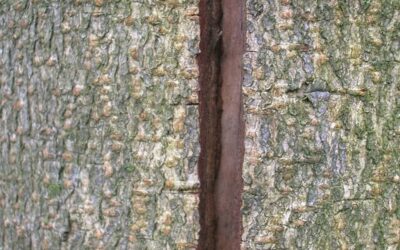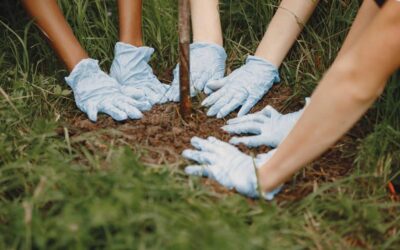Blog Topics
As temperatures warm and the days get longer, it’s time to turn our attention to evergreen trees and shrubs in Northern VA. Evergreen trees and shrubs play vital roles in providing wildlife habitat, enhancing landscapes, and offering year-round beauty in Northern Virginia’s natural environment. However, just like any other living organism, evergreens require some TLC, especially in the springtime.
In this article, we’ll explore some essential spring tree care tips for evergreens in Northern VA, ensuring that your trees stay healthy, vibrant, and beautiful throughout the season and beyond. We’ll look at both broadleaved evergreens, such as rhododendron and holly, and conifers like pine and yew. Whether you’re a seasoned tree enthusiast or a beginner looking to enhance your green thumb, these tips will help you create a thriving environment for your evergreens.
Key Spring Evergreen Care Tips
- Inspect evergreens for winter damage like browning needles, broken branches, and remove any winter protection like burlap wraps after the cold season passes.
- Spring is an ideal time to fertilize evergreens to replenish nutrients, encourage growth, and boost overall health. Conduct a soil test first and use slow-release, balanced fertilizers.
- Proper spring watering is crucial, providing 1 inch of water per week through deep soaking to reach the root zone without overwatering.
- Be vigilant about identifying and treating any pest infestations or diseases early through inspection and using organic or low-impact pesticides when needed.
- Prune evergreen trees minimally in late winter or early spring before new growth emerges, removing only dead, diseased or rubbing branches.
The Importance of Spring Tree Care for Evergreen Trees & Shrubs
Spring is a season of growth and renewal for plants, as well as a time to recover from the ravages of winter. Because evergreen trees and shrubs keep their leaves year-round, they’re often more prone to winter damage, making spring tree care vital to help them stay healthy and vibrant. By taking the necessary steps each spring, you can ensure that your evergreens thrive and continue to provide beauty, shade, and brilliant blossoms for years to come.
Basic Spring Tasks for Evergreen Tree Health
After a long and cold winter, spring brings new life and an opportunity to assess the health of your evergreen trees. Spring is the perfect time to evaluate the effects of winter on your evergreens and take necessary steps to ensure their well-being.
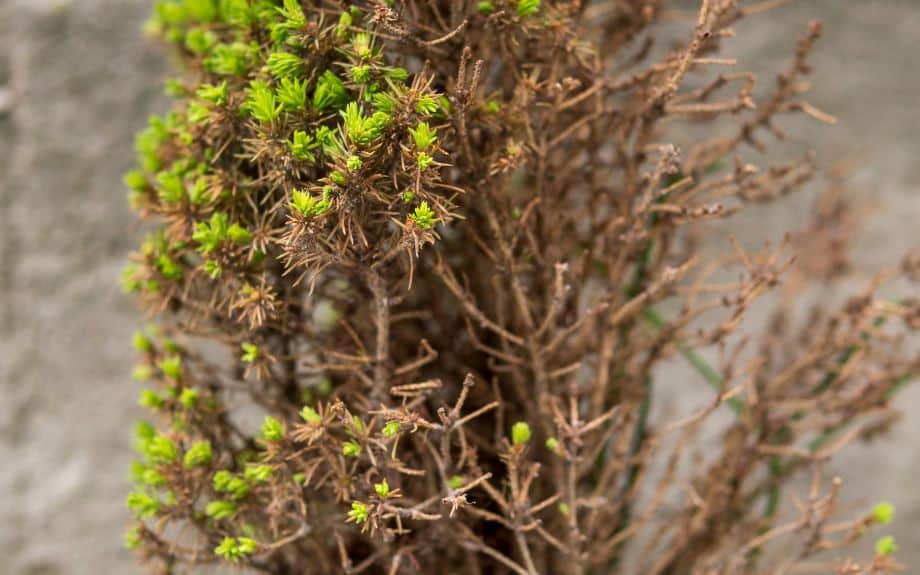
Look for Winter Damage
One important aspect of evergreen tree care is examining the foliage for any signs of damage. Winter can cause stress to all kinds of evergreens, leading to browning or yellowing needles on conifers and discolored or shriveled leaves on broadleaved evergreens.
Also check for broken, cracked, or hanging branches that could pose a risk to anything below the tree. These should be professionally pruned to prevent further damage or injury.
Spring Cleanup
Another crucial step in spring tree care is the removal of any debris or dead leaves that have collected around the base of your evergreen. This organic matter can trap moisture, providing an ideal environment for fungal diseases to thrive. By clearing away debris and improving airflow, you can help prevent the onset of common conifer tree diseases.
Remove Winter Protection
Many Northern Virginia residents prepare their evergreens for winter with practices like wrapping broadleaf evergreens in burlap and applying anti-desiccant sprays to preserve foliage from excessive winter drying. Other common winter protection measures include minimizing salt exposure, mulching new trees, staking young trees, and erecting snow covers to help protect them from winter-related challenges like winter burns, heavy snow loads, cold temperatures, and salt damage.
These protective measures should be removed in spring. Unwrap any trees or shrubs that were protected during winter and remove snow covers before temperatures rise too far.
Weed Removal
Clearing weeds from around evergreen shrubs and trees is crucial as they compete for nutrients and water. Spring is an excellent time to weed as roots are shallow, the soil is moist, and weeds grow slowly. After weeding, remove old mulch or leaves and apply a fresh layer of mulch to suppress future weed growth and maintain soil moisture levels.
Spring Fertilizing Tips for Healthy Evergreens
Spring is the perfect time of the year to give your evergreens a much-needed boost with some proper fertilization. As trees come out of their winter dormancy, it is crucial to provide them with the necessary nutrients to encourage vigorous growth, improve plant resilience against diseases and pests, and enhance their overall health and vigor.
Start With a Soil Test
Before beginning a fertilization program, we recommend conducting a soil test to determine the fertility of the soil. This test helps in understanding the existing nutrient levels and pH of the soil, helping you choose the appropriate fertilizer with the right balance of nitrogen, phosphate, and potash for your evergreen trees and shrubs.
Fertilize only if there are signs of nutrient deficiencies like decreased growth, leaf discoloration, or reduced production. Proper fertilization provides vital nutrients for optimal growth and health.
Choose Fertilizers Wisely
Consider using a slow-release, balanced fertilizer specifically formulated for evergreen trees and shrubs. This type of fertilizer will gradually release nutrients over an extended period, providing a steady supply of essential elements for the trees. We also recommend opting for an organic fertilizer to avoid any harmful chemicals entering the soil and affecting the trees’ natural ecosystem.
When applying the fertilizer, make sure to follow the manufacturer’s instructions regarding dosage and application method. Generally, you should spread the fertilizer evenly around the base of the evergreen trees, taking care to keep it at least a foot away from the trunk to avoid burning the tree. Using a spreader or hand-spreading the granules can ensure an even distribution. After applying the fertilizer, lightly water the trees to help the nutrients reach the roots effectively.
Watch For Nutrient Deficiencies
Regularly monitoring your evergreens’ overall health is essential during the spring season. Keep an eye out for any signs of nutrient deficiencies, such as yellowing or stunted growth. Adjusting the fertilizer dosage or type accordingly can help address these issues effectively.
Spring Watering Guidelines to Ensure Proper Hydration
During the winter months, evergreen trees can become dehydrated due to the lack of rainfall and desiccation from cold, drying winds. Providing adequate water in the spring helps replenish their moisture levels and ensures their health.
Evergreens generally have deep root systems and require less frequent watering. However, during the spring season, it’s still important to give them a good soaking to promote healthy growth. Follow these tips for proper spring watering:
- Deep watering is crucial for evergreens, allowing the roots to receive the necessary moisture. Make sure to water the trees thoroughly, ensuring that the water reaches the root zone.
- Avoid shallow watering, as it can lead to shallow root growth, making the trees more susceptible to stress and diseases. A slow, low-flow approach allows water time to infiltrate the soil properly, rather than just sitting on the surface.
- Try to water your plants early in the morning or late in the evening when the temperatures are cooler. This allows for better absorption and prevents water loss due to evaporation.
- Avoid overhead watering, as it can encourage the growth of fungal diseases. Instead, use a soaker hose or drip irrigation system to deliver water directly to the roots.
- Be mindful of the amount of water you provide. Overwatering can be just as harmful as under watering. A general rule of thumb is to provide about an inch of water per week, but this can vary depending on the type of evergreen, soil conditions, and your local climate. Regularly check the moisture levels in the soil and adjust your watering schedule accordingly.
Taking the time to implement these watering techniques will ensure that your plants stay hydrated and healthy throughout the spring season.
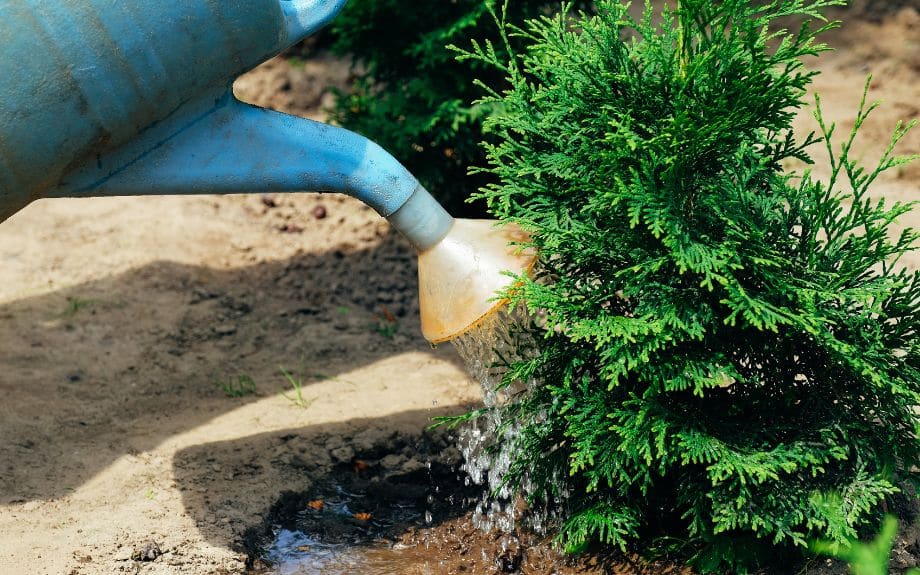
Spring Watering Guidelines for Newly Planted Trees
Newly planted trees, especially evergreens, require regular irrigation even in the spring season. We recommend supplying 1 inch of water per week for up to two years for newly planted trees that have not yet established their feeder roots into the surrounding soil. This consistent watering is essential to ensure that the trees receive sufficient moisture, especially as they enter their growing season and begin active growth.
Watering Mature Evergreens in Spring
For mature and well-established evergreen trees and shrubs, providing 1 inch of supplemental water applied to the root zone every week should help maintain adequate soil moisture levels during the spring months. Watering frequency may vary based on weather conditions and soil moisture levels, so it’s important to monitor the plants’ needs and adjust watering accordingly.
Protecting Evergreens from Pests and Diseases
Evergreens are a beautiful addition to any garden or landscape, providing year-round color and structure. However, these majestic trees are not immune to pests and diseases that can wreak havoc on their health and appearance.
There are several key steps you can take in spring to protect evergreen trees from pests and diseases in Northern Virginia:
Identify and Treat Diseases Early
Every spring season, inspect your evergreens closely. Insects such as scale, hemlock wooly adelgid, or bagworms can infest evergreens and cause damage. Regularly inspect the trees and shrubs for any signs of infestation, such as discolored or distorted needles, webbing, or visible insects. Also be on the lookout for for signs of diseases like Needlecast disease, which is a common fungal infection.
Early detection allows for prompt treatment, preventing severe damage. If you’re unsure about disease identification, seek help from an experienced Certified Arborist who can quickly diagnose the disease and recommend appropriate treatment and prevention measures.
Practice Proactive Pest Control
Be vigilant in identifying and addressing pest problems such as bagworms, scale insects, spider mites, boxwood leaf miners, and aphids that commonly affect evergreen shrubs. Early intervention and proactive pest protection measures can help prevent severe infestations and minimize damage to your trees.
Follow a Comprehensive Insect and Disease Management Program
Consider enrolling in a comprehensive insect and disease management program offered by professional tree care services like Riverbend Tree Service. These programs can help prevent many tree problems by providing immediate treatments to control existing insect infestations and bacterial or fungal diseases, thus safeguarding the health of your evergreen trees and shrubs.
Use Organic or Low-Impact Pesticides
Where possible, opt for organic or low-impact pesticides that minimize harm to beneficial insects and other wildlife while effectively controlling pests that threaten evergreen trees and shrubs. These treatments can be applied through spraying with a high-pressure sprayer, injection into the tree, or soil application.
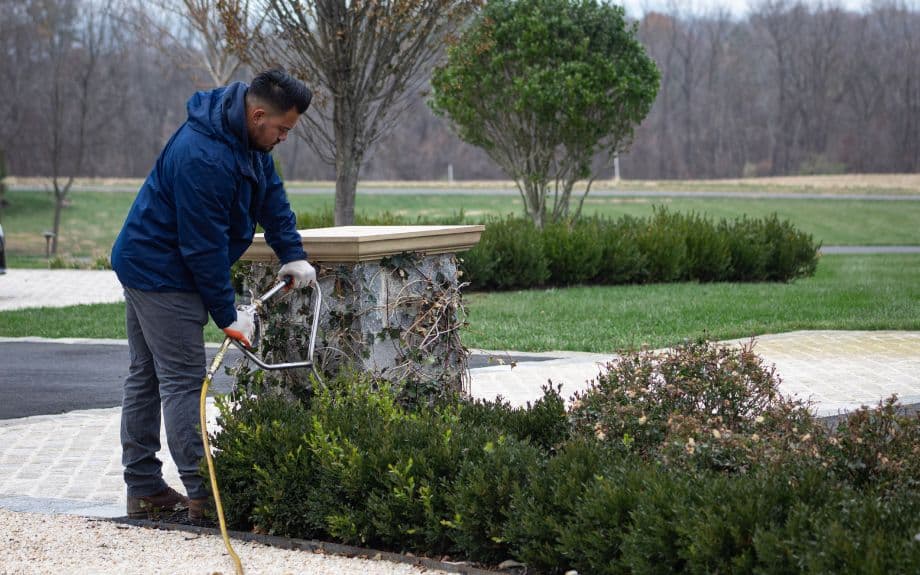
Keep Tree Root Systems Healthy
Ensuring strong, healthy roots is critical for the well-being of trees. Treatments that encourage root development and rejuvenate tree roots can help maintain the overall health and vitality of evergreen trees and shrubs, making them more resilient against pests and diseases.
Spring Mulching Strategies to Maintain Soil Moisture
Mulching around the base of your evergreens helps retain moisture, regulate soil temperature, provide nutrients and improve soil quality, and suppress weeds that compete with trees for nutrients. It also provides insulation during extreme temperature changes, such as spring-time freeze/thaw cycles and when summer suddenly arrives.
Apply a layer of organic mulch (such as pine bark, cedar, or hardwood bark mulch), approximately 2-4 inches deep, but ensure that it doesn’t touch the trunk of the tree, as this can trap moisture and lead to rot.
Spring Pruning for Evergreens: Yes or No?
The best time to prune conifers like Arborvitae, Atlas Cedar, Chamaecyparis, Juniper, Leyland Cypress, and Yew is in winter or early spring before new growth emerges. Most conifers do not regrow stems and branches that have been cut back to old wood so it’s important not to prune off too much. Occasional light pruning is better than major trimming.
However, you can remove any dead or diseased branches, as well as those that are crossing or rubbing against each other at any time. This improves the overall appearance of the tree, promotes airflow, and helps prevent the spread of diseases.
Overall, it’s best to avoid pruning evergreens in spring in Northern Virginia. Pruning during the dormant season ensures minimal stress on the plants and promotes healthy growth patterns without risking damage or interfering with their natural development cycle.
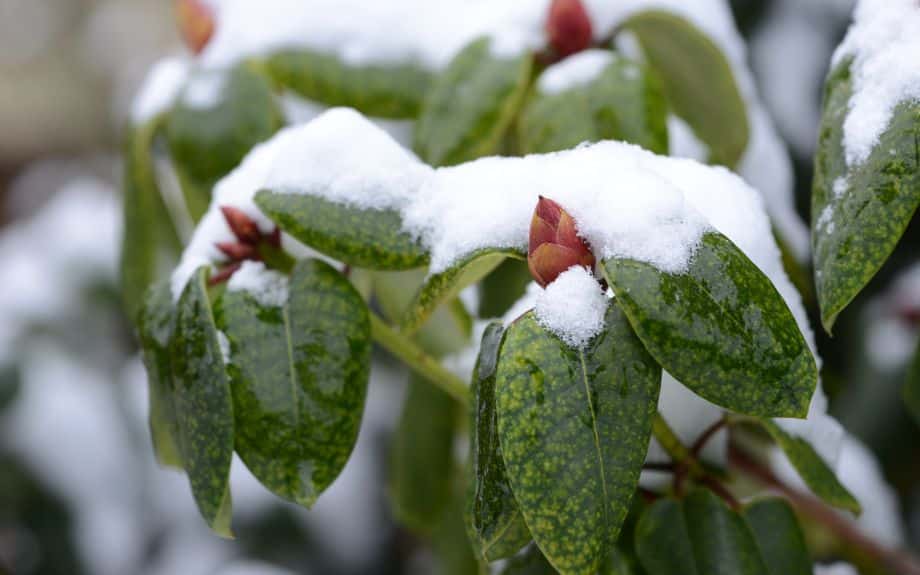
Rhododendrons and other broadleaf evergreens need attention during the spring months.
Are Your Evergreen Trees Ready for Spring?
As we approach spring, it’s important to pay special attention to evergreen trees. These trees require specific care to ensure they thrive throughout the year.
If you’re concerned about your evergreens, unsure what to do, or simply want someone else to do the work, Riverbend Tree Service has you covered with our spring tree care programs for evergreens in Northern VA.
For a comprehensive and professional approach to tree care in Northern VA, Riverbend Tree Service is the name to trust. You can rest assured that your trees will receive the best care possible, ensuring their health and longevity. Don’t hesitate to call Riverbend Tree Service at 703-402-9366 for all your tree care needs, including spring tree care for your evergreens. Your trees will thank you for it.
Give Us a Call at 703-402-9366
If you'd like help with your trees or landscape, have any questions, or would like to schedule an appointment with one of our Certified Arborists, please give us a call. We'd love to hear from you!


